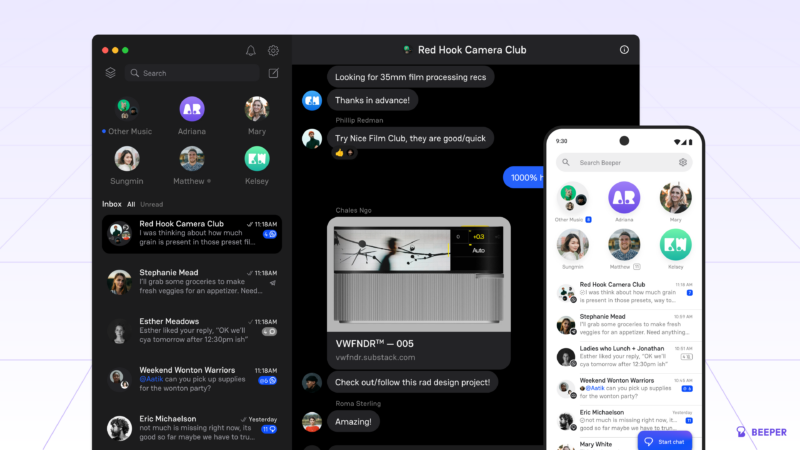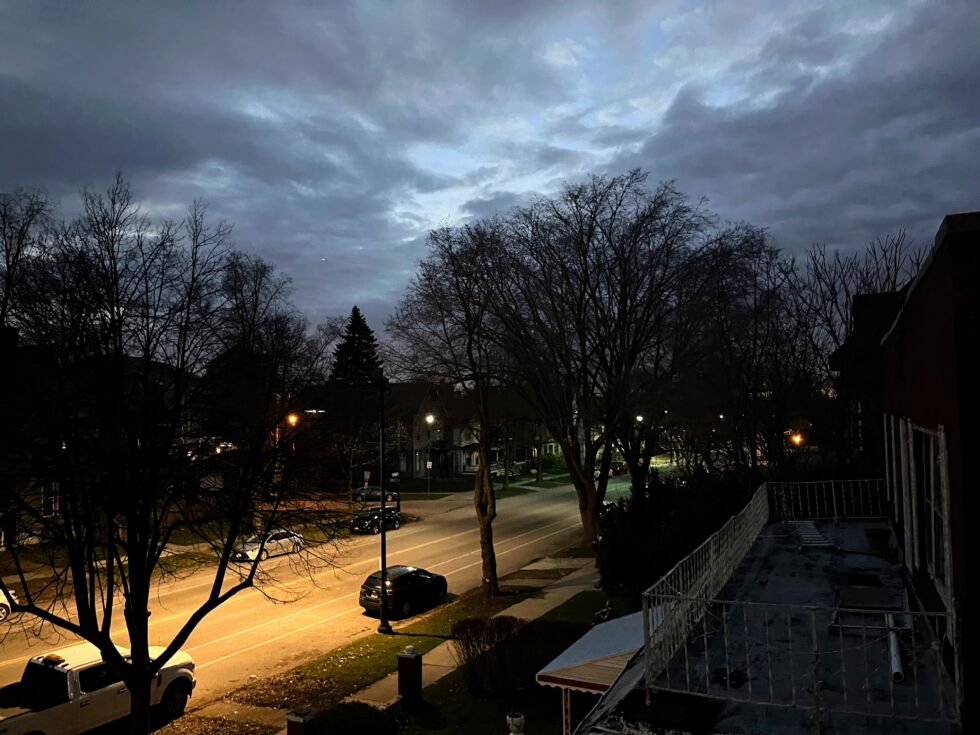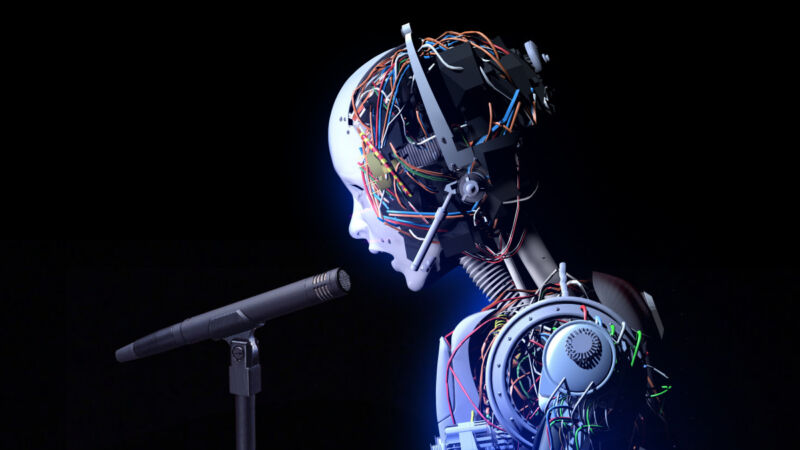U bent hier
Van dingen die voorbijkomen
“Google Vids” is Google’s fourth big productivity app for Workspace
-

Is that Google Slides? Nope it's Google Vids, the new video editor that seems to just make souped-up slideshows. [credit: Google ]
If you had asked me before what Google's video editor app was, I would say "YouTube Studio," but now Google Workspace has a new productivity app called "Google Vids." Normally a video editor is considered a secondary application in many productivity suites, but Google apparently imagines Vids as a major pillar of Workspace, saying Vids is an "all-in-one video creation app for work that will sit alongside Docs, Sheets and Slides." So that's editors for documents, spreadsheets, presentations, and videos?
Google's demo of the new video editor pitches the product not for YouTube videos or films, but more of as a corporate super slideshow for things like training materials or product demos. Really this "video editor" almost looks like it could completely replace Google Slides since the interface is just Slides but with a video timeline instead of a slideshow timeline.
Google's example video creates a "sales training video" that actually starts with a Slides presentation as the basic outline. You start with an outline editor, where each slideshow page gets its own major section. Google then has video "styles" you can pick from, which all seem very Powerpoint-y with a big title, subheading, and a slot for some kind of video. Google then wants you to write a script and either read it yourself or have a text-to-speech voice read the script. A "stock media" library lets you fill in some of those video slots with generic corporate imagery like a video of a sunset, choose background music, and use a few pictures. You can also fire up your webcam and record something, sort of like a pre-canned Zoom meeting. After that it's a lot of the usual Google productivity app features: real-time editing collaboration with visible mouse cursors from each participant and a stream of comments.
Thousands of LG TVs exposed to the world. Here’s how to ensure yours isn’t one.

Enlarge (credit: Getty Images)
As many as 91,000 LG TVs face the risk of being commandeered unless they receive a just-released security update patching four critical vulnerabilities discovered late last year.
The vulnerabilities are found in four LG TV models that collectively comprise slightly more than 88,000 units around the world, according to results returned by the Shodan search engine for Internet-connected devices. The vast majority of those units are located in South Korea, followed by Hong Kong, the US, Sweden, and Finland. The models are:
- LG43UM7000PLA running webOS 4.9.7 - 5.30.40
- OLED55CXPUA running webOS 5.5.0 - 04.50.51
- OLED48C1PUB running webOS 6.3.3-442 (kisscurl-kinglake) - 03.36.50
- OLED55A23LA running webOS 7.3.1-43 (mullet-mebin) - 03.33.85
Starting Wednesday, updates are available through these devices’ settings menu.
Report details how Russia obtains Starlink terminals for war in Ukraine

Enlarge / A Starlink terminal at the Everything Electric London conference on March 28, 2024 in England. (credit: Getty Images | John Keeble )
A report published today describes how Russia obtained Starlink terminals for its war in Ukraine despite US sanctions and SpaceX's insistence that Russia hasn't bought the terminals either directly or indirectly.
The Wall Street Journal report describes black market sales to Russians and a Sudanese paramilitary group called the Rapid Support Forces (RSF). US Secretary of State Antony Blinken recently determined that the Rapid Support Forces and allied militias committed war crimes and are responsible for ethnic cleansing in Darfur.
The WSJ said it "tracked Starlink sales on numerous Russian online retail platforms," "interviewed Russian and Sudanese middlemen and resellers, and followed Russian volunteer groups that deliver SpaceX hardware to the front line."
Elon Musk: AI will be smarter than any human around the end of next year

Enlarge / Elon Musk, owner of Tesla and the X (formerly Twitter) platform on January 22, 2024. (credit: Getty Images)
On Monday, Tesla CEO Elon Musk predicted the imminent rise in AI superintelligence during a live interview streamed on the social media platform X. "My guess is we'll have AI smarter than any one human probably around the end of next year," Musk said in his conversation with hedge fund manager Nicolai Tangen.
Just prior to that, Tangen had asked Musk, "What's your take on where we are in the AI race just now?" Musk told Tangen that AI "is the fastest advancing technology I've seen of any kind, and I've seen a lot of technology." He described computers dedicated to AI increasing in capability by "a factor of 10 every year, if not every six to nine months."
Musk made the prediction with an asterisk, saying that shortages of AI chips and high AI power demands could limit AI's capability until those issues are resolved. “Last year, it was chip-constrained,” Musk told Tangen. “People could not get enough Nvidia chips. This year, it’s transitioning to a voltage transformer supply. In a year or two, it’s just electricity supply.”
Intel is investigating game crashes on top-end Core i9 desktop CPUs

Enlarge / Intel's high-end Core i9-13900K and 14900K are reportedly having crashing problems in some games. (credit: Andrew Cunningham)
If you own a recent high-end Intel desktop CPU and you've been running into weird game crashes lately, you're not alone.
Scattered reports from Core i9-13900K and i9-14900K users over the last couple of months have pointed to processor power usage as a possible source of crashes even in relatively undemanding games like Fortnite. Games like Hogwarts Legacy, Remnant 2, Alan Wake 2, Horizon: Zero Dawn, The Last of Us Part 1, and Outpost: Infinity Siege have also reportedly been affected; the problem primarily seems to affect titles made with Epic's Unreal Engine. Intel said in a statement to ZDNet Korea (via The Verge) that it's looking into the problems, escalating it from an "isolated issue" to something that may be more widespread and could require a more systemic fix.
Related CPUs like the i9-13900KF, i9-14900KF, i9-13900KS, and i9-14900KS may be affected, too, since they're all the same basic silicon. Some user reports have also indicated that the i7-13700K and i7-14700K series may also be affected.
2,000 senior women win “biggest victory possible” in landmark climate case

Enlarge / Members of Swiss association Senior Women for Climate Protection react after the announcement of decisions after a hearing of the European Court of Human Rights (ECHR) to decide in three separate cases if states are doing enough in the face of global warming in rulings that could force them to do more, in Strasbourg, eastern France, on April 9, 2024. (credit: FREDERICK FLORIN / Contributor | AFP)
More than 2,000 older Swiss women have won a landmark European case proving that government climate inaction violates human rights.
The European Court of Human Rights (ECHR) ruled Tuesday that Switzerland had not acted urgently to achieve climate targets, leading victims, who are mostly in their 70s, to suffer physically and emotionally while potentially placed at risk of dying.
The women, part of a group called KlimaSeniorinnen (Senior Women for Climate Protection), filed the lawsuit nine years ago. They presented medical documents and scientific evidence that older women are more vulnerable to climate impacts, arguing that "their health and daily routines were affected" by Swiss heatwaves connected to climate change.
WordPress owner acquires Beeper, giving it two chat apps to rule them all

Enlarge / Beeper's new apps are now available, without waitlist, across nearly all mobile and desktop platforms.
Beeper, the multi-network messaging app that recently gave up on trying to engineer around Apple's walled-off iMessage service, has been acquired by Automattic, the company behind WordPress. It is now open to everyone and has a completely revamped Android app.
All of Beeper's workers will join Automattic and will continue operating as an independent team, according to a press release. Eric Migicovsky, creator of the Pebble smartwatch and co-founder of Beeper, will become Automattic's head of messaging. Beeper and Texts.com, acquired last year by Automattic, will work together.
Given that Texts.com provides a similar "all your chats in one place" function but also an iMessage bridge using an app you run on your own Apple computers, it's likely that Beeper and Texts will consolidate into one platform that more closely hews to the "all" part of the companies' mission statements.
Daily Mail gives a vivid description of what a nuclear attack on Washington DC would be like
Caribbean nation of Aruba backs itself up to Internet Archive

Enlarge / Divi Divi trees on a sandy beach in Aruba. (credit: Cavan Images via Getty)
Aruba has long been a special place for Stacy Argondizzo. For years, her family has vacationed on the tiny Caribbean Island every July. More recently it’s been more than just a place to take a break from her work as a digital archivist—becoming wholly a part of that work.
A project Argondizzo galvanized comes to full fruition this week. The Internet Archive is now home to the Aruba Collection, which hosts digitized versions of Aruba’s National Library, National Archives, and other institutions including an archaeology museum and the University of Aruba. The collection comprises 101,376 items so far—roughly one for each person who lives on the Island—including 40,000 documents, 60,000 images, and seven 3D objects.
Tesla settles Autopilot wrongful death suit, avoiding court trial

Enlarge / A photograph from the NTSB report into the crash. (credit: NTSB)
Yesterday, trial was due to begin in the case of Huang v. Tesla, a wrongful death lawsuit brought by the family of a man killed in his Tesla Model X in 2018. But the case will now not be heard by a judge—Tesla has settled with the family for an undisclosed sum.
Walter Huang was driving to work in his Model X on March 23, 2018, when his car drove headlong into a concrete divider at an exit on US Highway 101. Tesla's partially automated driving system, Autopilot, was active at the time, and Huang trusted it enough to play video games on his phone, despite having noticed that the car got confused at that particular intersection more than once.
The National Transportation Safety Board investigated Huang's death and published its findings in 2020. The NTSB found plenty of parties to blame. Tesla's misleading marketing of Autopilot, such as video interviews where the Tesla CEO operated the system without keeping his hands or eyes on the road, and a staged self-driving demonstration contributed to Huang's mistaken trust in Autopilot.
"On Gutting the Liberal Arts"
Reader comments on some philosophers who have recently died
Euthanasia in the Netherlands...
How Photos Were Transmitted by Wire in 1937: The Innovative Technology of a Century Ago
When did you last send someone a photo? That question may sound odd, owing to the sheer commonness of the act in question; in the twenty-twenties, we take photographs and share them worldwide without giving it a second thought. But in the nineteen-thirties, almost everyone who sent a photo did so through the mail, if they did it at all. Not that there weren’t more efficient means of transmission, at least to professionals in the cutting-edge newspaper industry: as dramatized in the short 1937 documentary above, the visual accompaniment to a sufficiently important scoop could also be sent in mere minutes through the miracle of wire.
“Traveling almost as fast as the telephone story, wired photos now go across the continent with the speed of light,” declares the narrator in breathless newsreel-announcer style. “It’s not a matter of sending the whole picture at once, but of separating the picture into fine lines, sending those lines over a wire, and assembling them at the other end.”
(adsbygoogle = window.adsbygoogle || []).push({}); . -->Illustrating this process is a clever mechanical prop involving two spindles on a hand crank, and a length of rope printed with the image of a car that unwinds from one spindle onto the other. To ensure the viewer’s complete understanding, animated diagrams also reveal the inner workings of the actual scanning, sending, and receiving apparatus.
This process may now seem impossibly cumbersome, but at the time it represented a leap forward for mass visual media. In the decades after the Second World War, the same basic principle — that of disassembling an image into lines at one point in order to reassemble it at another — would be employed in the homes and offices of ordinary Americans by devices such as the television set and fax machine. We know, as the viewers of 1937 didn’t, just how those analog technologies would change the character of life and work in the twentieth century. As for what their digital descendants will do to the twenty-first century, as they continue to break down all existence into not lines but bits, we’ve only just begun to find out.
Related content:
The History of Photography in Five Animated Minutes: From Camera Obscura to Camera Phone
Watch a Local TV Station Switch From Black & White to Color for First Time (1967)
Creative Uses of the Fax Machine: From Iggy Pop’s Bile to Stephen Hawking’s Snark
From the Annals of Optimism: The Newspaper Industry in 1981 Imagines its Digital Future
Based in Seoul, Colin Marshall writes and broadcasts on cities, language, and culture. His projects include the Substack newsletter Books on Cities, the book The Stateless City: a Walk through 21st-Century Los Angeles and the video series The City in Cinema. Follow him on Twitter at @colinmarshall or on Facebook.
Aldous Huxley, Dying of Cancer, Left This World Tripping on LSD (1963)
Aldous Huxley put himself forever on the intellectual map when he wrote the dystopian sci-fi novel Brave New World in 1931. (Listen to Huxley narrating a dramatized version here.) The British-born writer was living in Italy at the time, a continental intellectual par excellence.
Then, six years later, Huxley turned all of this upside down. He headed West, to Hollywood, the newest of the New World, where he took a stab at writing screenplays (with not much luck) and started experimenting with mysticism and psychedelics — first mescaline in 1953, then LSD in 1955. This put Huxley at the forefront of the counterculture’s experimentation with psychedelic drugs, something he documented in his 1954 book, The Doors of Perception.
(adsbygoogle = window.adsbygoogle || []).push({}); . -->Huxley’s experimentation continued until his death in November 1963. When cancer brought him to his deathbed, he asked his wife to inject him with “LSD, 100 µg, intramuscular.” He died tripping later that day, just hours after Kennedy’s assassination. Three years later, LSD was officially banned in California.
By way of footnote, it’s worth mentioning that the American medical establishment is now giving hallucinogens a second look, conducting controlled studies of how psilocybin and other psychedelics can help treat patients dealing with cancer, obsessive-compulsive disorder, post-traumatic stress disorder, drug/alcohol addiction and end-of-life anxiety.
For a look at the history of LSD, we recommend the 2002 film Hofmann’s Potion by Canadian filmmaker Connie Littlefield. You can watch it here.
If you would like to sign up for Open Culture’s free email newsletter, please find it here. Or follow our posts on Threads, Facebook, BlueSky or Mastodon.
If you would like to support the mission of Open Culture, consider making a donation to our site. It’s hard to rely 100% on ads, and your contributions will help us continue providing the best free cultural and educational materials to learners everywhere. You can contribute through PayPal, Patreon, and Venmo (@openculture). Thanks!
Related Content:
Ken Kesey’s First LSD Trip Animated
Aldous Huxley Predicts in 1950 What the World Will Look Like in the Year 2000
Justitie doorzocht zonder wettelijke grondslag telefoon van vreemdeling
Justitie heeft een telefoon ontgrendeld en doorzocht van een vreemdeling die in bewaring was gesteld, zonder dat hier toereikende wettelijke grondslag voor was. Dat las ik bij Tweakers vorige week. De Raad van State had namelijk bepaald dat onder de Vreemdelingenwet 2000 ambtenaren niet bevoegd zijn om telefoons te doorzoeken, ondanks dat de wet (art. 59) vrij letterlijk zegt van wel. Wat is hier aan de hand?
Het ging om een Mongoolse vrouw die in vreemdelingenbewaring was gesteld: Een ambtenaar van de Afdeling Vreemdelingenpolitie, Identificatie en Mensenhandel hoopte op haar telefoon foto’s van identiteitsdocumenten te vinden, zodat hij meer informatie kon krijgen over haar identiteit. De vrouw gaf echter geen toestemming voor het ontgrendelen van de telefoon. De ambtenaar hield daarop de telefoon voor haar gezicht, zodat deze alsnog ontgrendelde. Vervolgens heeft de werknemer handmatig de telefoon doorzocht. Het voelt voor mij een tikje dun dat je iemands telefoon zou mogen doorzoeken op basis van de speculatie dat daar wellicht identiteitsdocumenten op staan, maar goed. De ambtenaar meende dat dat mocht, want artikel 59 Vreemdelingenwet 2000 bepaalt immers in lid 8 dat De ambtenaren belast met de grensbewaking en de ambtenaren belast met het toezicht op vreemdelingen zijn bevoegd de in bewaring gestelde persoon aan diens kleding of lichaam te onderzoeken, alsmede zaken van deze persoon te doorzoeken, voor zover dit noodzakelijk is voor het verkrijgen van informatie omtrent de identiteit, nationaliteit en de verblijfsrechtelijke positie van de betreffende vreemdeling. Bij invoering van de wet (Kamerstukken II, 2011/2012, 32 528, nr. 6, blz. 5 en 9) is gezegd dat met ‘zaken’ ook een mobiele telefoon wordt bedoeld. In 2011/12 geen gekke opmerking – dat was gewoon een ding waarmee je kon bellen en sms’jes kon versturen (en soms ook bewaren), maar dat was het wel zo ongeveer.
In 2024 is een mobieltje een wezenlijk anders ding: je hele leven staat erop – ik heb ze wel eens privacybommen horen noemen, om die reden. Dat betekent dat je als burger meer bescherming van je persoonlijke levenssfeer mag verwachten als het gaat om dingen aan je telefoon. De Hoge Raad bevestigde dat in een strafzaak in alweer 2017, en daarna is in het strafrecht een getrapt kader ontwikkeld voor doorzoeking aan telefoons van verdachten.
Het gaat hier alleen om vreemdelingenrecht en niet strafrecht, en het is dan geen gegeven dat regels van dat laatste ook gelden. De Raad van State gooit het over een andere boeg: omdat het niet gaat om strafrecht, is gewoon de AVG van toepassing (in plaats van de Wet politiegegevens en Wet justitiële en strafvorderlijke gegevens). Doorzoeken van een telefoon is geautomatiseerd verwerken van persoonsgegevens, soms zelfs van bijzondere gegevens.
Natuurlijk is artikel 59 Vw dan een wettelijke basis, waarmee je komt bij de grondslag van uitoefening van het openbaar gezag (art. 6(1)(e) AVG) uitkomt. Alleen is dat artikel een tikje generiek en open, en dat is een probleem: naarmate de inmenging in een grondrecht ernstiger is, moet de wettelijke grondslag daarvoor nauwkeuriger zijn (vaste EHRM-jurisprudentie). Als de wet dat zelf niet doet, dan zul je op zijn minst een duidelijk afwegingskader moeten hebben waarbinnen de ambtenaren mogen werken: Naar aanleiding van een vraag van de Afdeling op de zitting hoe die afweging er in de praktijk uitziet, heeft de staatssecretaris toegelicht dat in een proces-verbaal wordt vastgelegd wat er wordt uitgevoerd, welke relevante gegevens worden gevonden en waarom die relevant zijn, maar niet op basis waarvan de beslissing om een telefoon te onderzoeken wordt genomen. De staatssecretaris heeft bevestigd dat er geen nader regelgevend kader is aan de hand waarvan ambtenaren hun beslissing om een mobiele telefoon te onderzoeken nemen. Er is niet eens een verslag van de afwegingen of werkwijze bij een specifieke doorzoeking. Dat is alles bij elkaar een werkwijze in strijd met de AVG en meer algemeen een serieuze kans op willekeur – iedereen doet maar wat, en als vreemdeling kun je daar niets tegen doen. Dat maakt dat het doorzoeken niet toegestaan is onder dit artikel.
Arnoud
Het bericht Justitie doorzocht zonder wettelijke grondslag telefoon van vreemdeling verscheen eerst op Ius Mentis.
Moments of totality: How Ars experienced the eclipse

Enlarge / Baily's Beads are visible in this shot taken by Stephen Clark in Athens, Texas. (credit: Stephen Clark)
"And God said, Let there be light: and there was light. And God saw the light, that it was good: and God divided the light from the darkness. And God called the light Day, and the darkness he called Night. And the evening and the morning were the first day."
The steady rhythm of the night-day, dark-light progression is a phenomenon acknowledged in ancient sacred texts as a given. When it's interrupted, people take notice. In the days leading up to the eclipse, excitement within the Ars Orbiting HQ grew, and plans to experience the last total eclipse in the continental United States until 2045 were made. Here's what we saw across the country.
Kevin Purdy (watched from Buffalo, New York)-

3:19 pm on April 8 in Buffalo overlooking Richmond Ave. near Symphony Circle. [credit: Kevin Purdy ]
Buffalo, New York, is a frequently passed-over city. Super Bowl victories, the shift away from Great Lakes shipping and American-made steel, being the second-largest city in a state that contains New York City: This city doesn’t get many breaks.
Teen’s vocal cords act like coin slot in worst-case ingestion accident

Enlarge (credit: Getty | Archive Photos)
Most of the time, when kids accidentally gulp down a non-edible object, it travels toward the stomach. In the best-case scenarios for these unfortunate events, it's a small, benign object that safely sees itself out in a day or two. But in the worst-case scenarios, it can go down an entirely different path.
That was the case for a poor teen in California, who somehow swallowed a quarter. The quarter didn’t head down the esophagus and toward the stomach, but veered into the airway, sliding passed the vocal cords like they were a vending-machine coin slot.

Radiographs of the chest (Panel A, postero- anterior view) and neck (Panel B, lateral view). Removal with optical forceps (Panel C and Video 1), and reinspection of ulceration (Panel D, asterisks) (credit: NEJM, Hsue and Patel, 2024)
In a clinical report published recently in the New England Journal of Medicine, doctors who treated the 14-year-old boy reported how they found—and later retrieved—the quarter from its unusual and dangerous resting place. Once it passed the vocal cords and the glottis, the coin got lodged in the subglottis, a small region between the vocal cords and the trachea.
MIT License text becomes viral “sad girl” piano ballad generated by AI

Enlarge (credit: Getty Images)
We've come a long way since primitive AI music generators in 2022. Today, AI tools like Suno.ai allow any series of words to become song lyrics, including inside jokes (as you'll see below). On Wednesday, prompt engineer Riley Goodside tweeted an AI-generated song created with the prompt "sad girl with piano performs the text of the MIT License," and it began to circulate widely in the AI community online.
The MIT License is a famous permissive software license created in the late 1980s, frequently used in open source projects. "My favorite part of this is ~1:25 it nails 'WARRANTIES OF MERCHANTABILITY' with a beautiful Imogen Heap-style glissando then immediately pronounces 'FITNESS' as 'fistiff,'" Goodside wrote on X.
Suno (which means "listen" in Hindi) was formed in 2023 in Cambridge, Massachusetts. It's the brainchild of Michael Shulman, Georg Kucsko, Martin Camacho, and Keenan Freyberg, who formerly worked at companies like Meta and TikTok. Suno has already attracted big-name partners, such as Microsoft, which announced the integration of an earlier version of the Suno engine into Bing Chat last December. Today, Suno is on v3 of its model, which can create temporally coherent two-minute songs in many different genres.









































































































![Reference manager - [Onderhoud aantekeningen]](http://labyrinth.rienkjonker.nl/sites/default/files/styles/medium/public/Reference%20manager%20v3%20-%20%5BOnderhoud%20aantekeningen%5D%2014-2-2010%20102617_0.jpg?itok=OJkkWhxY)
![Reference manager - [Onderhoud aantekeningen]](http://labyrinth.rienkjonker.nl/sites/default/files/styles/medium/public/Reference%20manager%20v3%20-%20%5BOnderhoud%20aantekeningen%5D%2014-2-2010%20102628.jpg?itok=CUvhRRr7)
![Reference manager - [Onderhoud bronnen] - Opnemen en onderhouden](http://labyrinth.rienkjonker.nl/sites/default/files/styles/medium/public/Reference%20manager%20v3%20-%20%5BOnderhoud%20bronnen%5D%2014-2-2010%20102418.jpg?itok=d7rnOhhK)
![Reference manager - [Onderhoud bronnen]](http://labyrinth.rienkjonker.nl/sites/default/files/styles/medium/public/Reference%20manager%20v3%20-%20%5BOnderhoud%20bronnen%5D%2014-2-2010%20102433.jpg?itok=CgS8R6cS)
![Reference manager - [Onderhoud bronnen]](http://labyrinth.rienkjonker.nl/sites/default/files/styles/medium/public/Reference%20manager%20v3%20-%20%5BOnderhoud%20bronnen%5D%2014-2-2010%20102445_0.jpg?itok=4oJ07yFZ)
![Reference manager - [Onderhoud bronnen]](http://labyrinth.rienkjonker.nl/sites/default/files/styles/medium/public/Reference%20manager%20v3%20-%20%5BOnderhoud%20bronnen%5D%2014-2-2010%20102500.jpg?itok=ExHJRjAO)
![Reference manager - [Onderhoud bronnen]](http://labyrinth.rienkjonker.nl/sites/default/files/styles/medium/public/Reference%20manager%20v3%20-%20%5BOnderhoud%20bronnen%5D%2014-2-2010%20102524.jpg?itok=IeHaYl_M)
![Reference manager - [Onderhoud bronnen]](http://labyrinth.rienkjonker.nl/sites/default/files/styles/medium/public/Reference%20manager%20v3%20-%20%5BOnderhoud%20bronnen%5D%2014-2-2010%20102534.jpg?itok=cdKP4u3I)
![Reference manager - [Onderhoud thema's en rubrieken]](http://labyrinth.rienkjonker.nl/sites/default/files/styles/medium/public/Reference%20manager%20v3%20-%20%5BOnderhoud%20themas%20en%20rubrieken%5D%2020-9-2009%20185626.jpg?itok=zM5uJ2Sf)













![Reference manager - [Raadplegen aantekeningen]](http://labyrinth.rienkjonker.nl/sites/default/files/styles/medium/public/Reference%20manager%20v3%20-%20%5BRaadplegen%20aantekeningen%5D%2020-9-2009%20185612.jpg?itok=RnX2qguF)
![Reference manager - [Relatie termen (thesaurus)]](http://labyrinth.rienkjonker.nl/sites/default/files/styles/medium/public/Reference%20manager%20v3%20-%20%5BRelatie%20termen%20%28thesaurus%29%5D%2014-2-2010%20102751.jpg?itok=SmxubGMD)
![Reference manager - [Thesaurus raadplegen]](http://labyrinth.rienkjonker.nl/sites/default/files/styles/medium/public/Reference%20manager%20v3%20-%20%5BThesaurus%20raadplegen%5D%2014-2-2010%20102732.jpg?itok=FWvNcckL)
![Reference manager - [Zoek thema en rubrieken]](http://labyrinth.rienkjonker.nl/sites/default/files/styles/medium/public/Reference%20manager%20v3%20-%20%5BZoek%20thema%20en%20rubrieken%5D%2020-9-2009%20185546.jpg?itok=6sUOZbvL)
![Reference manager - [Onderhoud rubrieken]](http://labyrinth.rienkjonker.nl/sites/default/files/styles/medium/public/Reference%20manager%20v3%2020-9-2009%20185634.jpg?itok=oZ8RFfVI)

![Reference manager - [Onderhoud aantekeningen]](http://labyrinth.rienkjonker.nl/sites/default/files/styles/medium/public/Reference%20manager%20v3%20-%20%5BOnderhoud%20aantekeningen%5D%2014-2-2010%20102603.jpg?itok=XMMJmuWz)


































































